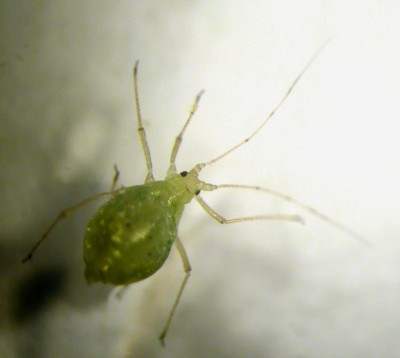Pests
Macrosiphum euphorbiae Thom. - Potato Aphid
Systematic position.
Class Insecta, order Homoptera, suborder Aphidinea, superfamily Aphidoidea, family Aphididae, subfamily Aphidinae, tribe Macrosiphini, subtribe Macrosiphina, genus Macrosiphum.Biological group.
Oligophagous pests of vegetables and potato.Morphology and biology.
The fusiform body of apterous female is green, sometimes red. Its length reaches 4 mm. Frons has a flute with rather small tubercle in its middle part. Antennae are dark at junctions and are considerably longer than body. Antennal tubercle is high, divergent. Siphunculi are light, cylindrical, with dark tips and operculi, reaching one third the body length. Tail is 2.5 times shorter than siphunculi, light, sword-shaped with 6-12 hairs. Legs are light. Winged female has dark head, thorax, apices of legs and femora, and green abdomen. Antennal segments I-IV darkened. Eggs are oval, black. Within the territory of the Former Soviet Union, the parthenogenetic females winter under cover in the northern regions and on weeds in the southern regions. In the zone of strong damage, their emergence takes place at the middle of April. At first, the aphids feed on perennial weeds, preferring plants of the family Chenopodiaceae. In May or beginning of June (depending on zone), the insects migrate to potato, cabbage, tomato and others cultures where they feed on young shoots, lower side of leaves, buds, flowers. The aphids prefer leaves of the lower layer. Fecundity of one female varies from 34 to 50 larvae, up to 70 under optimal conditions. Life span of apterous parthenogenetic female is about 22-38 days. Aphids live openly, not forming big colonies.Distribution.
The species is spread in Europe, Anterior and Middle Asia, North America. Within the territory of the Former Soviet Union, it occurs widely where its hosts-plants grow. The northern border of its area goes along the northern border of main potato-growing zone. In closed ground, the pest is observed in more northern regions. Its high harming activity is marked in some of southern regions of Russia, in Moldova, the South and Southwest of Ukraine.Ecology.
These insects are observed at the temperatures 3.3-5°C, but the aphids are mainly active at the temperatures 12-13°C. The most favorable conditions for apterous females are the temperatures 21-26°C and humidity 60-80%. The air temperature 30°C and higher greatly inhibits population development. The high number of insects is marked from July to September. The pest gives 10 or more generations during a year. The most important predators are Chrysopa carnea Steph, Ch. perla L., Ch. vulgaris Schn., Coccinella septempunctata L., C. quinquepunctata L., Adalia bipunctata L., Adonia variegate Goeze, Propylaea quatuordecimpunctata L., Syrphus corollae F., S. balteatus Deg., Ephedrus plagiator Nees., Aphidencyrtus aphidivorus Mayr.Economic significance.
Potato aphid damages potato, tomato, aubergine, cucumber, lettuce, cabbage, pepper, melons and gourds, and others cultures. It feeds on potato in August-September, on aubergine in July, on tomato July-September. Different plant species have characteristic symptoms of damage; injured leaves of cucumber have yellow net; tomato leaves have round yellow spots at places of aphid feeding. Damaged leaves dry up. Fecal masses pollute the leaves. Control measures include eradication of weeds, insecticide treatments. Duly forecast of pest appearance and number is rather important.Reference citations:
Adashkevich B., Stary P., Popov N. 1972. Aphididae (Hymenoptera) - parasites of aphids on vegetables, melons and gourds, potato. In: Zhuchenko A.A., ed. Protection of vegetables (Proc. of Moldova institute of water agriculture and vegetables growing). Kishinev: Moldovenyaske. 28-35 p. (in Russian).Barlow C.A. 1962. Development, survival, and fecundity of the potato aphid Macrosiphum euphorbiae (Thomas), at constant temperatures. The Canadian Entomologist 94(6): 667-672 (in Russian).
Bobryshev F.I., Chmulev V.M., Udovitskii A.S., Zakharov A.I. 1972. Dynamics of aphid migration to potato. In: Lisunov V.I., ed. Plant protection against pests and diseases (Proc. Stavropol' SKhI). Stavropol': Stavropol' SKhI. 102-105 p. (in Russian).
Bozhko M.P. 1976. Aphids of food plants. Khar'kov: Vishcha shkola. 134 p. (in Russian).
Chechuev N. 1973. Aphids on potato in Kazakhstan. Kartofel' i ovoshchi 6: 41 (in Russian)/
Damroze I.P. 1970. The species composition of aphids on potato in Latvian SSR. In: Materials VII conference on plant protection. Part I. Elgava: 75-77 (in Russian).
D'yakonov K.P., Romanova S.A., Ledneva V.A. 1994. New interest to potato aphid. Zashchita rastenii 5: 40-42 (in Russian).
Ivanovskaya O.I. 1973. Ecological-faunistic complexes in West Siberia. In: Cherepanov A.I., ed. Results of investigations the living nature of Siberia. Novosibirsk: Nauka: 97-104 (in Russian).
Ivanovskaya O.I. 1976. Fauna of aphids on the territory of West Siberia. In: Zolotorenko G.S., ed. Fauna of helminthes and arthropods of Siberia. Novosibirsk: Nauka. P. 175-189 (in Russian).
Khandybarenko T.T. 1981. Basis of agrobiological measures on seed potato protection against aphids - virus-carrying agents. PhD Thesis. Kiev: Ukrainian plant protection institute, 41 p. (in Russian).
Lytaeva G.K, Nemchin F.I. 1972. Dynamics of winged aphids on potato in Moldova. In: Zhuchenko A.A., ed. Protection of vegetables (Proc. of Moldova institute of water agriculture and vegetables growing). Kishinev: Moldovenyaske. 96-98 p. (in Russian).
Nevskii V.P. 1929. Aphids of Middle Asia. Proceedings of Uzbekistan Experimental plant protection station 16. Tashkent. 58-73 p. (in Russian).
Shaposhnikov G.Kh. 1964. Suborder Aphidinea . aphids. In: Bei-Bienko G.Ya., ed. Keys to insects of the European part of the USSR. V. 1. Moscow & Leningrad: Nauka. 612 p. (in Russian).
Shaposhnikov G.Kh. 1972. Order Homoptera - homopterous. In: Kryzhanovskii O.L., ed. Insects and mites - pests of agricultural crops. V. 1. Leningrad: Nauka. 183 p. (in Russian).
Vasil.ev V.P., ed. 1973. Pests of agricultural crops and forest plantations. 1. Kiev: Urozhai, 303 p.(in Russian).
Zalene G. 1965. Aphids on potato in Lithuanian SSR. In: Materials of 5th conference on plant protection. Vilnius: Newspaper-magazine publishing house, 96-98 p. (in Russian).
Zhukova M.I. 2000. Aphids on potato in Byelorussia and control measures. In: Sorochinskii L.V., ed. Akhova raslin 4. Minsk: AN Byelorussia. 16-18 p. (in Russian).


